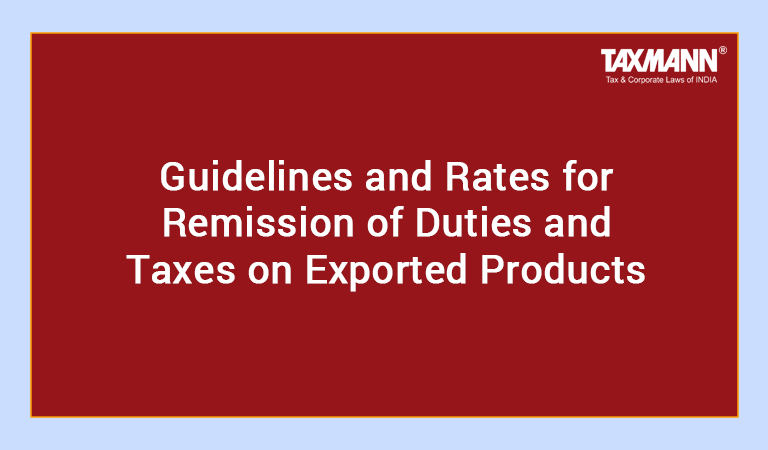Guidelines and Rates for Remission of Duties and Taxes on Exported Products (RoDTEP)
- Blog|GST & Customs|
- 3 Min Read
- By Taxmann
- |
- Last Updated on 26 August, 2021
Table of Content:
1. The RoDTEP Scheme
2. Key Features of the Scheme
3. Ineligible supplies for benefit under the Scheme
4. Procedures, Rules etc. yet to be notified

In the year 2018, United States of America had filed a claim to World Trade Organization (‘WTO’) alleging that India is providing various export incentive schemes which prohibits the Subsidies and Countervailing Measures Agreement (SCM Agreement) entered between the member Countries of WTO. The WTO panel, in October 2019, ruled in the favor of USA and asked India to withdraw various subsidies. The Indian Government has filed an appeal before the appellate forum against this decision.
In the year 2020, the Government has announced a new scheme referred as Remission of Duties and Taxes on Exported Products (‘RoDTEP’). This scheme is referred as WTO compliant scheme and is effective from January 01, 2021.
1. The RoDTEP Scheme
Initially, the scheme was made effective without notifying the rates of rebate and the guidelines relating to the scheme. In this regard, recently, the Government has notified the scheme guidelines and the rates.
RoDTEP scheme has replaced the existing MEIS scheme with the objective to reimburse the taxes and duties paid at the Central, State and Local level incurred by the exporters such as Local Taxes, Coal Cess, Mandi Tax, Electricity Duties, Tax on petroleum products for transportation of goods, etc. which are not getting exempted or refunded under any other existing scheme so that benefit of zero rate can be achieved
2. Key Features of the Scheme
The Key features of the RoDTEP Scheme are as follows:
-
Manner of the rebate
The Rebate would be granted, at a notified rate as a percentage of FOB value subject to a value cap per unit of the exported product. The Scheme provides the rate for rebate on 8,555 items. The scheme provides the maximum and the minimum rate of rebate of 4.3% and 0.01%, respectively. However, for certain items, a fixed amount of rebate per unit is also notifies such as Mobile Phones at Rs. 24.50/unit.
The rebate would be granted in the form of e-scrips. These e-scrips can be utilized only for the payment of Basic Customs Duty (BCD). In other words, the scrips cannot be utilized for the payment of IGST, Social Welfare Surcharge, Agriculture Infrastructure and Development (AID) Cess, etc.
-
Realization of the sale proceeds
The Realization of the sale proceeds is not a pre-requisite for applying for the benefit under the scheme. However, it is required to be realized within the time as per the provisions of the FEMA law. In a case, where the benefit under the scheme is availed and the proceeds were not realized within the time as per FEMA law, then the benefit will deemed to be not allowed.
-
Safeguards in relation to other benefits
The guidelines notified in this regard provides that safeguards relating to Drawback Schemes and GST refunds relating to exports would also be applicable for claiming benefit under RoDTEP Scheme.
3. Ineligible supplies for benefit under the Scheme
Rebate under the RoDTEP scheme would not be available in the case of following supplies (illustrative):
- Export of imported goods
- Exports through trans-shipment
- Products which are prohibited & restricted under the Exports Policy
- Supplies to SEZ/FTWZ units
- Deemed Exports
- Products manufactured in EHTP and BTP
- Products partly or wholly manufactured under Bonded Warehouse
- Exports made through non-EDI ports
- Used goods
- Products manufactured or exported in discharge of various export incentive schemes such as Advance Authorization, DFIA, SAA, EOU, units located in EPZ, SEZ, FTZ (inclusion of exports made by these units in this scheme along with the incentive rates would later be decided based on the recommendation of RoDTEP Committee)
4. Procedures, Rules etc. yet to be notified
Sequence of introduction of scheme across sectors, prioritization of sectors to be covered, degree of benefits to be given on various items within the rate set by the Committee, etc. would be decided and notified by the Government. Government would review the rates annually and will notify the revised rates where required.
CBIC would notify necessary rules and procedures regarding grant of claim under the Scheme and other implementation issues such as manner of application, time period of application, etc.
Disclaimer: The content/information published on the website is only for general information of the user and shall not be construed as legal advice. While the Taxmann has exercised reasonable efforts to ensure the veracity of information/content published, Taxmann shall be under no liability in any manner whatsoever for incorrect information, if any.

Taxmann Publications has a dedicated in-house Research & Editorial Team. This team consists of a team of Chartered Accountants, Company Secretaries, and Lawyers. This team works under the guidance and supervision of editor-in-chief Mr Rakesh Bhargava.
The Research and Editorial Team is responsible for developing reliable and accurate content for the readers. The team follows the six-sigma approach to achieve the benchmark of zero error in its publications and research platforms. The team ensures that the following publication guidelines are thoroughly followed while developing the content:
- The statutory material is obtained only from the authorized and reliable sources
- All the latest developments in the judicial and legislative fields are covered
- Prepare the analytical write-ups on current, controversial, and important issues to help the readers to understand the concept and its implications
- Every content published by Taxmann is complete, accurate and lucid
- All evidence-based statements are supported with proper reference to Section, Circular No., Notification No. or citations
- The golden rules of grammar, style and consistency are thoroughly followed
- Font and size that’s easy to read and remain consistent across all imprint and digital publications are applied





